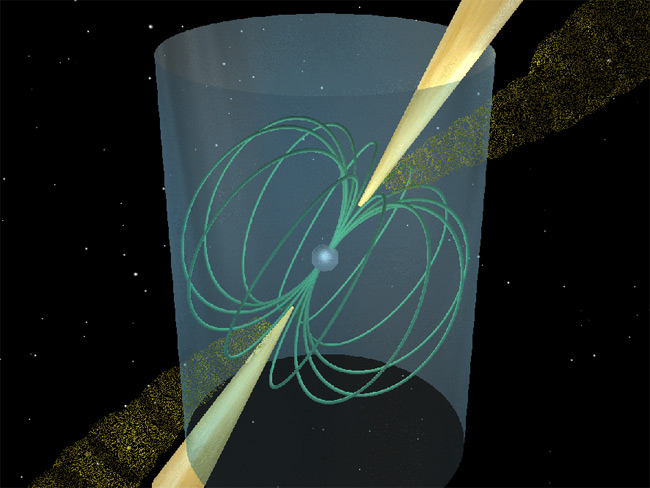Pulsing Stars May Be Most Accurate Clocks In the Universe

Rapidly spinning stars that pulse over time could be used asthe universes's most accurate clocks, thanks to a new discovery thathelps explain how they rotate.
Astronomers have long hoped to use these stars, calledpulsars, as time-keepers but slight irregularities in their spinning rates haveso far prevented those plans. But a new understanding could enable scientiststo compensate for it.
Pulsars are created when stars collapse and become so densethat protons and electrons squish together to becomeneutrons. After the star's mass is condensed into a small volume,conservation of angular momentum causes the pulsar to rotate extremely rapidly? up to hundreds of revolutions per second.
Pulsars emit a steady ray of light that sweeps around like alighthouse beam as they rotate ? thus, their light appears to pulse on and offas the beam crosses our line of sight.
This pulsing is almost perfectly steady ? but not quite.Slight variations in the observed puling rate have been unexplained, until now.
Timing the cosmos
A team led by astronomer Andrew Lyne of the University ofManchester in the United Kingdom used data from Lovell telescope at theuniversity's Jodrell Bank Observatory to find that the deviations arise becausethe pulsarsare slowly spinning down, and they are doing so at two different rates. Thepulsars seem to switch between these spin-down rates abruptly andunpredictably.
Get the Space.com Newsletter
Breaking space news, the latest updates on rocket launches, skywatching events and more!
Detailed measurements of a pulsar's light at any particulartime should indicate what its slowdown rate is, and allow astronomers tocalculate and apply a correction. That should greatly improve pulsars'usefulness as cosmic clocks.
"Mankind?s best clocks all need corrections, perhapsfor the effects of changing temperature, atmospheric pressure, humidity orlocal magnetic field," Lyne said in a statement. "Here, we have founda potential means of correcting an astrophysical clock."
Ripples in space-time
Scientists hope that pulsar clocks can be applied to thequestion of gravitationalwaves. Einstein's theory of general relativity suggests that powerfulevents such as the merging of two supermassive black holes will create ripplesin space-time that spread out through the universe.
These waves have never before been detected, but pulsars maybe the key to finding them.
For example, if a gravitational wave passed through apulsar, it would cause the pulsing rate to change. If these changes could bemeasured very accurately, scientists may be able to prove the existence ofgravitational waves.
"Many observatories around the world are attempting touse pulsars in order to detect the gravitationalwaves that are expected to be created by supermassive binary black holes inthe universe," said co-researcher Ingrid Stairs of the University ofBritish Columbia. "With our new technique we may be able to reveal thegravitational wave signals that are currently hidden because of the irregularitiesin the pulsar rotation."
The researchers detailed their findings in a paper publishedonline June 24 in the journal Science.
- Top 10 Star Mysteries
- The Strangest Things in Space
- Video: Pulsars: Death and Rebirth
Join our Space Forums to keep talking space on the latest missions, night sky and more! And if you have a news tip, correction or comment, let us know at: community@space.com.

Clara Moskowitz is a science and space writer who joined the Space.com team in 2008 and served as Assistant Managing Editor from 2011 to 2013. Clara has a bachelor's degree in astronomy and physics from Wesleyan University, and a graduate certificate in science writing from the University of California, Santa Cruz. She covers everything from astronomy to human spaceflight and once aced a NASTAR suborbital spaceflight training program for space missions. Clara is currently Associate Editor of Scientific American. To see her latest project is, follow Clara on Twitter.









